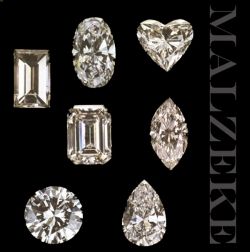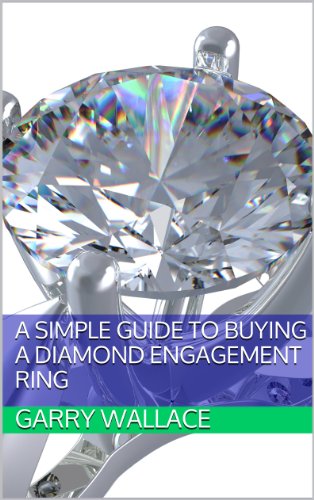DOs and DON’Ts for Buying a Diamond Engagement ring

How to buy the "RIGHT" diamond engagement ring!
How do I begin to buy the "right" diamond engagement ring? After all, diamonds represent the love of one for another as clear, pure, brilliant, perfect and indestructible. The diamond you ultimately pick will say to your loved one, "you are my one and only."
Sadly to say diamond dealers can fool you in hundreds of ways. But for many of us blind ignorance can cost more than what we bargain for. Remember all diamonds can look great under spotlights. I spent a lot of time researching this topic in hopes that this information will aid anyone in finding the right diamond. For many, this is one of the most important purchases in a lifetime.

Before Shopping for the Right Diamond Engagement ring
Using the Loupe
Be sure you have a loupe when you begin looking at diamonds. Feel confident in using this handy tool. It is a must! This is the loupe I carry with me all the time.
I was recently in a antique store where a pretty bracelet was marked with a tag, "14k gold, sapphires, diamonds, bracelet". To the naked eye it looked nice. I took out my loupe to take a closer look only to find out they were not sapphires, but onyx. The gold marking was 10k and there were no diamonds but white gold configurations to trick the eye. The point here: the price is way off for what it actually is.
More so is true of buying a diamond. The jeweler can tell you one thing...
Become a knowledgeable buyer so you know what to ask and what to look for.
THE MUST HAVE LIST

Finding the right jeweler is important. Looking at rings together is also very important. How else will you know what shape, style, size, white gold, yellow gold, platinum, or any other kinds of stones set along side the diamond they will want? But finding the right source is everything. These "must haves" are a necessary aid to getting what you will ultimately be happy with.
Buying a Large Expensive Diamond?

If you are looking to purchase a large diamond and plan to put some money into it you really should consider buying from a bonded jeweler. They are very rare so chances are you might not be able to purchase in your own home town. Only one out of every twenty jewelers are bonded. But you are getting your money's worth if you go this route. All bonded diamonds are guaranteed to be natural and untreated. With a bonded jeweler you will buy a diamond that will forever look good!
Buying the Diamond Engagement Ring on the Internet

TRICKS OF THE TRADE

The diamond business is a tough business and a lot of money changes hands. There are very reputable sellers out there you just need to take your time. Research carefully and most of all learn as much about diamonds so you are prepared to ask the right questions and be sure they get answered to your best knowledge. Knowledge is power!
1. Be sure your purchase is all written out. Have the jeweler show you all blemishes, inclusions and have them DRAWN out plotted on a diagramed diamond. When you pick up your ring check the diamond with the jeweler against this paperwork.
2. Grade bumping is really quite common. Always ask if the diamond is GIA certified. If it isn't insist that the sale be contingent on the stone being certified. You won't get bumped if the jeweler knows the stone will get checked.
3. Never let anyone try to talk you into anything. Especially a diamond! Take control!
ART DECO Diamond Engagement Ring
I find eBay is a great source for getting ideas. Especially from older antique styles. It is true buying a diamond ring in this manner is taking chances. However, the person selling the older ring gains nothing from taking any stones out and replacing them with something else. You can get a lovely ring for the setting and replace the diamond with a nicer one later, or older cut diamonds are making a come back and are still considered very valuable!
In this page I have three period rings for you to look at. Have fun exploring!
THE ALL IMPORTANT 4 "C's" & WHAT THEY ADD UP TO - Clarity, Cut, Color, Carat = COST

The image of this diamond is a good representation of what you can see when looking through a loupe. Can you find the clouds, carbon,
pinpoints, and crystal formation?
Quality of diamond clarity is rated with these notations:
VVs1 and VVS2 = Very, very slightly included (Rare and very expensive)
VS1 and VS2 = Very slightly included ( high quality)
SI = slightly included (still "eye clean")
SI2 = slightly included (some flaws may be visible to the naked eye.)
I1 = Commercial grade
I2 = Not pretty
I3 = in the bottom of the barrel!
The "IDEAL" Diamond Cut & Proportion

Even though todays emphasis is on the "ideal" cut there is still some controversy over the best cut. The truth is that diamonds exhibit somewhat different "personalities" depending on how they are cut. Your eye will make the final determination. The bottom line is to compare many diamonds against one another. If a stone looks "dead" or dark at the center than the stone is suffering from poor cutting and proportioning.
PROPORTIONS MADE EASY FOR THE BUYER

The Gemological Institute of America (GIA) has made it easier to determine if a diamond is well-proportioned by dividing all cut diamonds into four classes.
CLASS I AND CLASS II = DIAMONDS WELL-PROPORTIONED (EXCELLENT TO GOOD)
CLASS III AND CLASS IV = POORLY PROPORTIONED (POOR TO BAD)
EVALUATING THE COLOR OF A DIAMOND

To an untrained eye, discerning the difference from a colorless diamond to a faint yellowish diamond without comparison, is almost impossible. However, the color greatly influences the price. The letter grading system that represents color, was introduced by the Gemological Institute of America (GIA) and is used extensively in the diamond trade worldwide. The best way to evaluate color is to ask the jeweler for a master set to compare against. The best color grade to aim for is between the G, H and I.
D, E, F = COLORLESS
G, H, I = NEAR COLORLESS
J, K, L = SLIGHTLY YELLOW
M, N, O = LIGHT YELLOW
P, Q, R, S, T, U, V, W, X = DARKER YELLOW ( NOT CONSIDERED VALUABLE)
Z = RARE FANCY COLORS
MORE IMPORTANT DIAMOND FACTS

Carats! The Bigger the Better?

I want a BIG diamond In my ring
Is having a large diamond what it's really all about? Or can you live with a smaller prettier diamond?
Which would you choose?
Edwardian Diamond Engagement Rings
Perhaps an older style ring setting has more appeal.
Helpful Books On Amazon
Victorian Diamond Engagement Rings
Have you thought about the older settings? You can purchase a lovely older style and put a new diamond in. The older styles were made to last. JUST A THOUGHT?
Hello. At least drop me a line!










